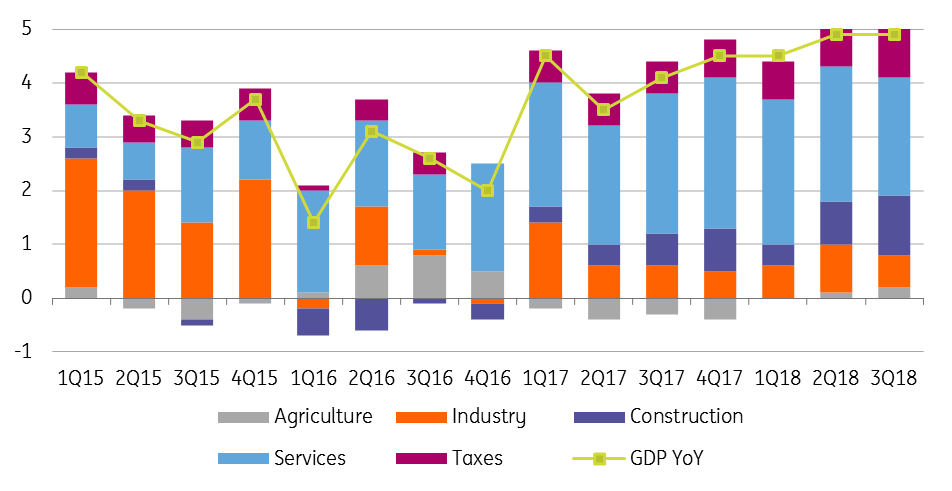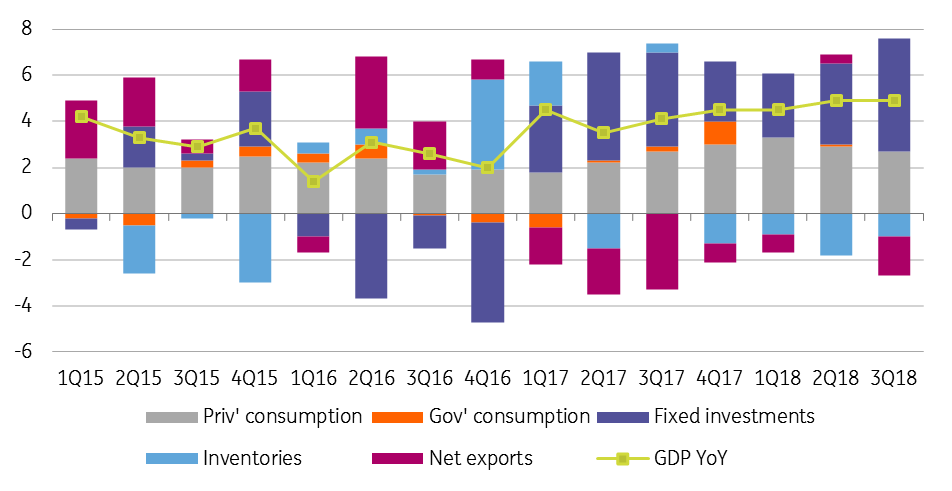Hungary’s growth structure shows imbalance
The revised 3Q18 GDP growth number was the strongest performance since 2004, but the structure of economic activity is now highly imbalanced, which is why we think the current growth path is unsustainable
| 4.9% |
GDP growth YoYConsensus (4.8%) / Previous (4.8%) |
| Better than expected | |
Growth looks wide-based on the production side
The detailed 3Q18 GDP release caused an upside surprise yet again as the Hungarian Central Statistical Office (HCSO) changed the advance reading by 0.1ppt to 4.9% year on year, which means, that Hungary posted its highest growth rate since 2004. The data adjusted for working days and seasonal factors shows a 5.2% YoY growth rate - the highest since the change of regime.
GDP growth revised up to 4.9% YoY in 3Q18
On the production side, we can see the value added of services increasing at a slower pace of 3.8% YoY in the third quarter. In line with the slow down, services provided a lower contribution to the GDP growth in 3Q (2.2ppt) than in 2Q (2.5ppt). Value added in the industry also increased at a lower rate, showing an expansion of 2.7% YoY.
This hardly comes as a surprise, as the industry is continuously facing capacity constraints and temporary challenges like the emission test saga. However, despite the slowdown, smaller sectors of the Hungarian economy posted strong growth figures, counterbalancing the drags on GDP growth.
Services sector provides the majority of economic activity
Construction accelerated by 27.5% YoY in 3Q18 despite the high base, but still driven mainly by the government pre-financed EU projects, thus infrastructural projects. The contribution of the construction sector came in at 1.1ppt, the second highest among the leading sectors.
Agriculture also provided a positive surprise with its 3.4% YoY growth. The contribution of net taxes on products reached a remarkable and record high of 0.9ppt. As this is basically the income of the government, we see this as a sign of the increasing extra revenue due to the combination of two things: (1) strong economic performance and (2) the retreat of the shadow economy.
Contributions to GDP growth – production side (% YoY)

Major imbalances on the expenditure side
Taking into consideration the expenditure side, the main drivers behind the GDP growth have remained domestic factors.
The domestic use (actual final consumption and gross capital formation) increased by 7.2% YoY, adding 6.7ppt to the economic activity, which means that the net export had a negative contribution reaching almost 1.7ppt. In absolute terms, this has been the second widest margin between the external and internal drivers since the 2008-2009 crisis. The last time, when the imbalances favoured the domestic factors this big was in 2002-2003. The Hungarian economy then stepped on a widely imbalanced growth path, culminating in high internal and external indebtedness.
Obviously, this time is different as the current account balance still sees surpluses and the external vulnerabilities and indebtedness of the economy decreased remarkably. However, such a wide gap between the internal and external drivers of an economy may mark an unsustainable growth path going forward.
The difference between the domestic and external factors are as high as in 2008-2009 in absolute terms
Within the domestic use, actual final consumption of households rose by 4.7% YoY, while the actual final consumption of government grew by 0.1% YoY, both showing deceleration. Overall, actual final consumption in total marked a 2.7ppt contribution to economic activity in 3Q18, 0.3ppt less than in the second quarter.
The investment activity counterbalanced this "loss": the 20% YoY increase in gross fixed capital formation translated into a 4.9ppt contribution. Inventories were also a drag on growth as 1) companies selling their stocks as they are facing capacity constraints in production and 2) the previously initiated investments were activated in the books, thus decreasing the inventories, but increasing the fixed investments in the national accounts.
On the external side of the economic activity, we see the import growth outpacing the export’s, mainly on the back of the still strong domestic demand (affecting the import side) and constraint in the industry (affecting the export side). This difference translated into the 1.7ppt negative net export contribution.
Contributions to GDP growth – expenditure side (% YoY)

The pace of economic activity is unsustainable
Despite the recent surprises provided by the Hungarian GDP growth, we stick to our view, that the loss of economic momentum will finally show up, translating into a prolonged deceleration in the GDP growth.
Our Hungarian Business Economy indicators are also supporting our call. The recent economic activity, as we pointed out earlier, contains a lot of structural imbalances and one-off effects, especially in the form of budgetary spending on EU projects.
Growth to remain robust, but a prolonged deceleration is expected
Here, we also need to point out to the expected deceleration in the economic activity among our main export partners. Moreover, the recent strong domestic demand and missing external growth drivers might lead to a not necessarily welcomed external imbalance (read: further significant deterioration in the current account).
If the government really doesn’t want to see a twin deficit anymore, it needs the economy to cool down, using both the monetary and fiscal policies. Against this backdrop, we see the GDP growth slowing down from 4.8% in 2018 as a whole to 3.8% in 2019 and 2.7% in 2020.
This publication has been prepared by ING solely for information purposes irrespective of a particular user's means, financial situation or investment objectives. The information does not constitute investment recommendation, and nor is it investment, legal or tax advice or an offer or solicitation to purchase or sell any financial instrument. Read more
Download
Download article